|

To Index Home Page
last updated on 6th July 2003
To View The Images:
Click
IMAGES ONLY
Then use your mouse
with the slider on the right of this frame
to view the 40 + images.
OR
To Read The Full Tutorial Text
And See All The Images:
Click
FULL TUTORIAL


Tutorial No.7. - Image 000a
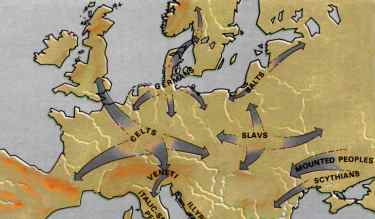
Map marking the area dominated or colonized during the middle of the 1st Millennium BC
Click for detail map.

Tutorial No.7. - Image 000b
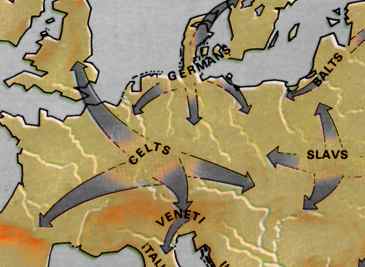
Detail map showing some of the main centresduring this period.
Click to return to original map. 

Tutorial No.7. - Image 000t Quick Find List of Tutorial Topics

Tutorial No.7. - Image 001
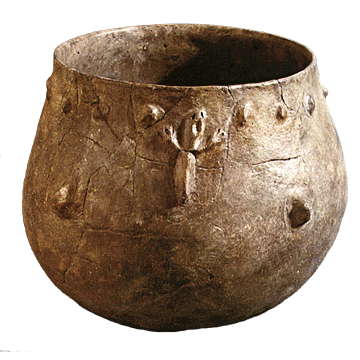
Rounded pot with human figure in relief. ca 4000 BC ht:25cm Bavaria, Germany PSM.

Tutorial No.7. - Image 002
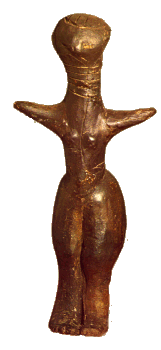
Clay female figurine ca.3400 BC. ht:15cm. Moravia,Slovakia. MMS.

Tutorial No.7. - Image 003
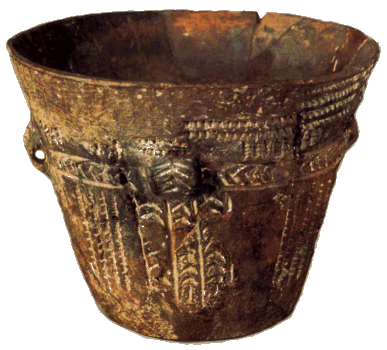
Pierced lug beaker, Northern Megalithic Age ca.3000 BC. From a long barrow at Drouwen, Drente, Holland.RL.

Tutorial No.7. - Image 004
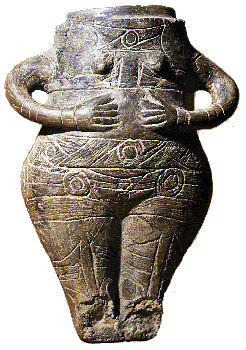
Female figurine clay jar. ht:21cm. Scratched decoration with traces of colour. ca.1800 BC. Vidra, south of Bucharest, Romania NMAB.

Tutorial No.7. - Image 005
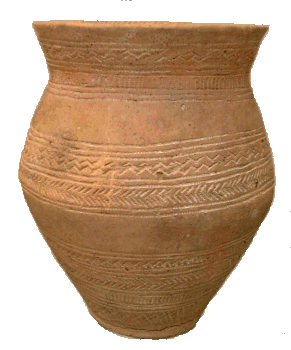
Small late Neolithic clay beaker with patterns produced by impressed dotted decoration. It was made about in Britain ca.2000 BC. BM

Tutorial No.7. - Image 006
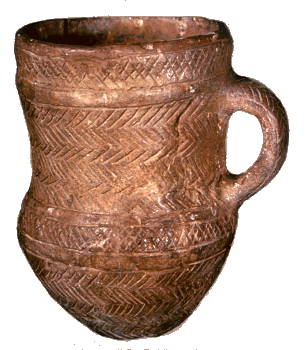
Hand made small mug or beaker with scratched zig-zag patterns. "Beaker Folk", England ca.2000 BC ht:15cm.BM

Tutorial No.7. - Image 007
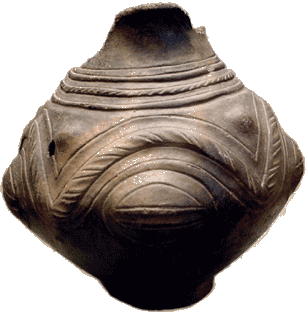
Late Bronze Age globular coiled vessel BM.

Tutorial No.7. - Image 008
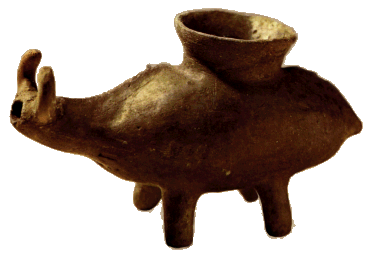
Horned animal-shaped pottery vessel. ht:13cm. ca.1100 BC Urnfield culture. Hrub-cice, Czechoslovakia. OC.

Tutorial No.7. - Image 009
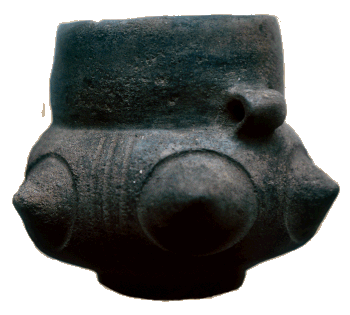
Jar of smooth surfaced clay with small ring handles and pushed out bosses. ca.1400-1100 BC Lusatian culture Bronze Age. Spreewald E. Germany BM.

Tutorial No.7. - Image 010
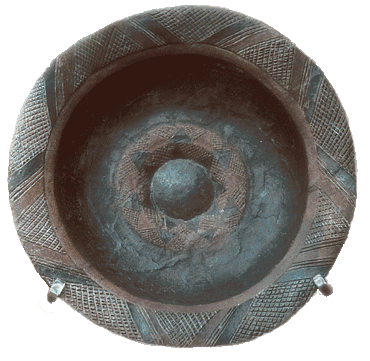
Large scratch-decorated dish, part blackened with graphite. ca.700 BC Hallstatt culture BM

Tutorial No.7. - Image 011
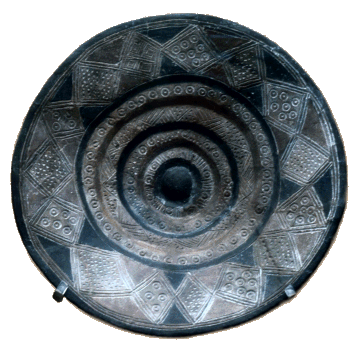
A Dish with concentric steps. The impressed and incised decoration is heightened by the contrasting areas of red clay and black graphite rubbed in a polished. ca.8-7th century BC Hallstatt culture. BM.

Tutorial No.7. - Image 012
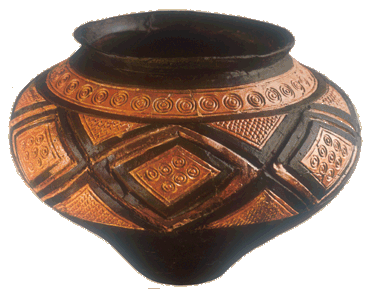
Large cone-shaped pot with outward turned lip. Incised and impressed ornamentation, parts blackened with graphite. ht:26cm ca.700 BC Hallstatt culture .Baden-Württemburg, Germany. WLS.

Tutorial No.7. - Image 013
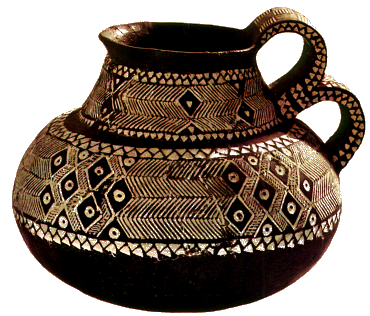
Shiny black pottery jug, incised decoration filled with white slip. ht:10cm. ca.700 BC. Hallstatt culture Bavaria, Germany PSM.

Tutorial No.7. - Image 014
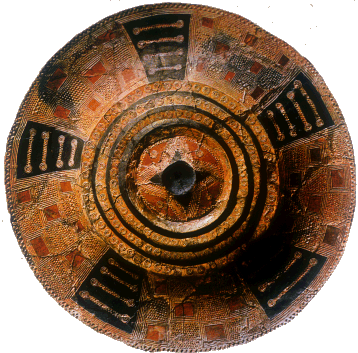
Large painted pottery bowl with stepped cross-section. Impressed decoration dm:54cm. ca.700 BC. Hallstatt culture. Baden-Württenberg, Germany. WLS.

Tutorial No.7. - Image 015
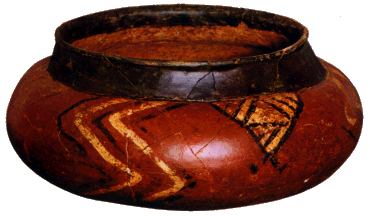
Small globular bowl. Slip painted and burnished. ht:9.5cm ca.700 BC. Hallstatt culture. Bavaria, Germany PSM.

Tutorial No.7. - Image 016
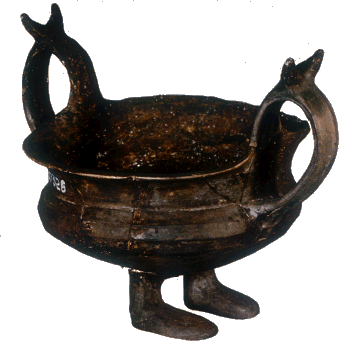
Clay bowl with horned handles and human feet. Bowl ht:8cm ca.700 BC Hallstatt culture. Lednice, Moravia, Czechoslovakia. MMB.

Tutorial No.7. - Image 017
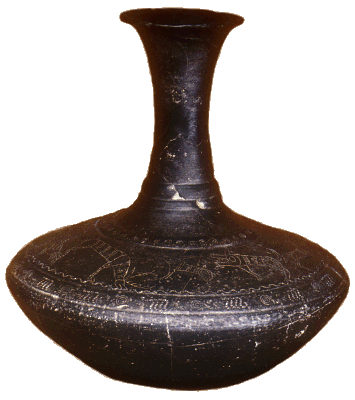
Lentiform clay bottle with impressed patterns and engraved animal frieze on the shoulder. ca.500 BC La Tène culture. Matzhausen, Bavaria, Germany MV-FB

Tutorial No.7. - Image 018
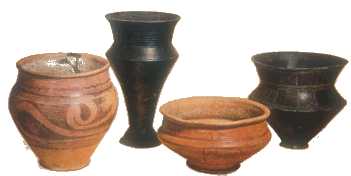
A collection of Early La Tène culture Iron Age pottery from Marne, France ca. 600-100 BC.BM.

Tutorial No.7. - Image 019
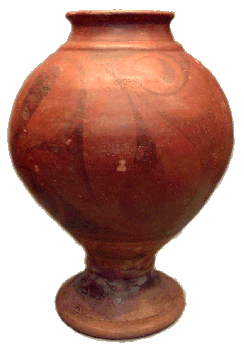
Painted Urn from Prunay, N.France Late La Tèene culture 5-3rd century BC ht:12.2cm BM.

Tutorial No.7. - Image 020
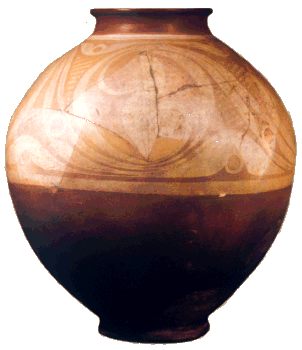 
Large globular jar fine slip decoration ht:36cm. ca.100 BC. Late La Tène culture. Basel Switzerland. HMB.

Tutorial No.7. - Image 020m
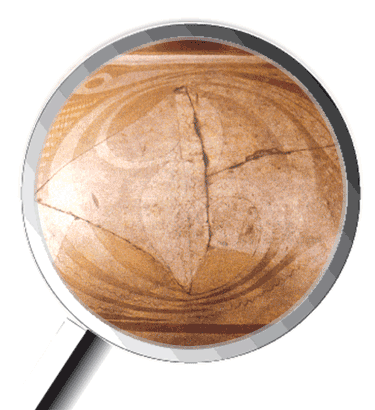
Large globular jar fine slip decoration ht:36cm. ca.100 BC. Late La Tène culture. Basel Switzerland. HMB.

Tutorial No.7. - Image 021
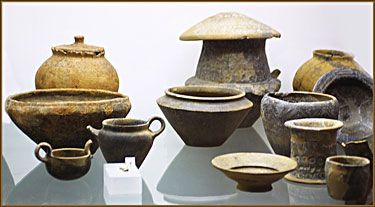
Villanovan Cinerary urns and other grave gifts. MCB.

Tutorial No.7. - Image 022
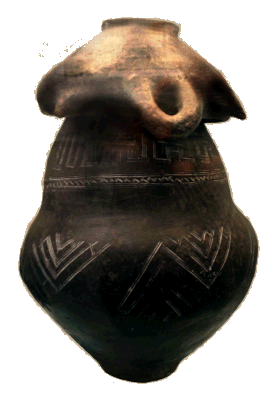
A Large Cinerary Urn with Helmet Lid. Villanovan Culture VJR.

Tutorial No.7. - Image 023
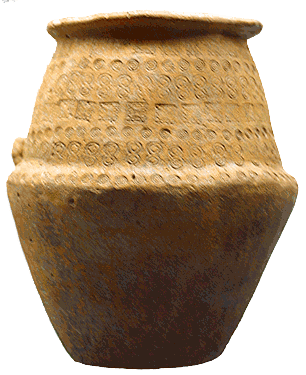 
A Large Cinerary Urn decorated with stamped patterns. Villanovan Culture VJR.

Tutorial No.7. - Image 023a
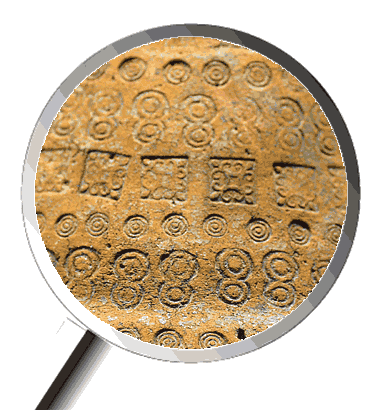
Detail of stamped patterns. Villanovan Culture VJR.

Tutorial No.7. - Image 024
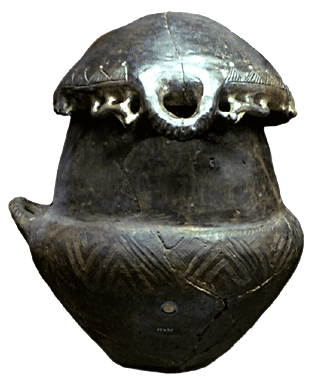
A Large Cinerary Urn with Helmet Lid. Villanovan Culture AMB.

Tutorial No.7. - Image 025
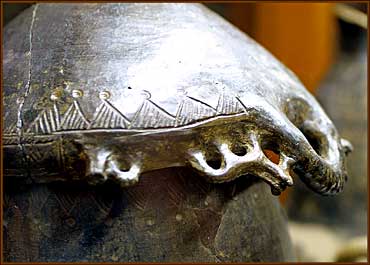
Detail: The helmet lid edge with animal figures. Villanovan Culture AMB.

Tutorial No.7. - Image 026
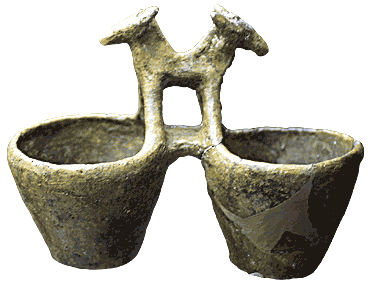
Cups joined with animal handle. Villanovan Culture AMB.

Tutorial No.7. - Image 027
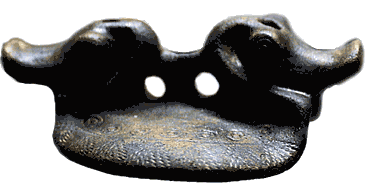
Small grave object with modelled ducks and two holes - for rope? Villanovan Culture AMB.

Tutorial No.7. - Image 028
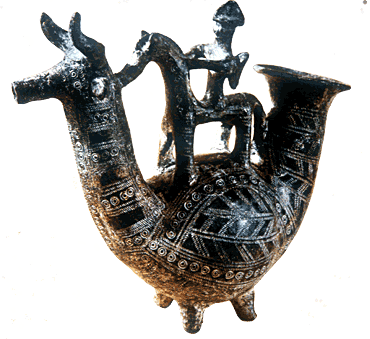
An Askó - ceremonial pouring vessel modelled horse and rider and with impressed decoration. Villanovan III Ca 7th.C. BC Bologna. MCB.

Tutorial No.7. - Image 029
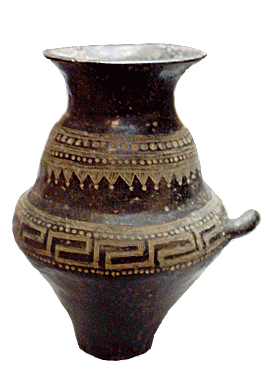
A Large Cinerary Urn. Villanovan Culture VJR.

Tutorial No.7. - Image 030
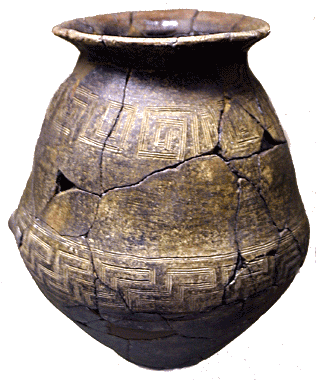
A Large Cinerary Urn. Villanovan Culture VJR.


Tutorial No.7. - Image 031
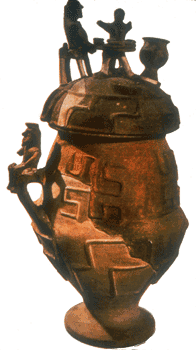 
Cinerary Urn with modelled figures and decoration. ca.750 BC. Monte Scudaio, Volterra. MAF.

Tutorial No.7. - Image 031a
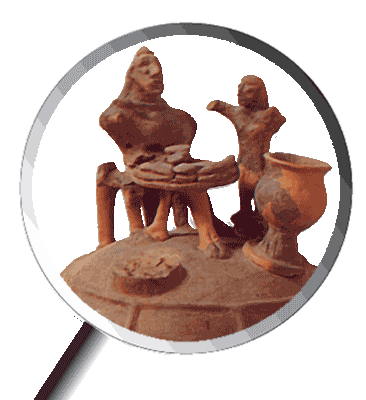
Detail of figure on lid. Cinerary Urn with modelled figures and decoration. ca.750 BC. Monte Scudaio, Volterra. MAF.

Tutorial No.7. - Image 032
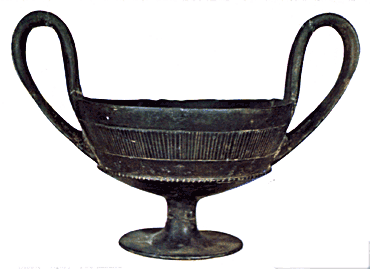
Two handled cup(blackware) Villanovan/Etruscan ca.720 BC

Tutorial No.7. - Image 033
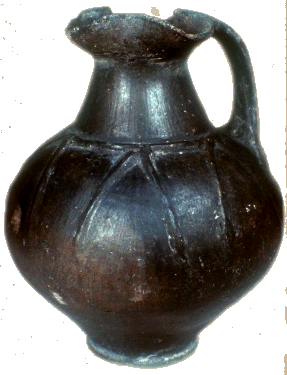
Bucchero (blackware) Jug. Etruscan ca.600 BC

Tutorial No.7. - Image 034
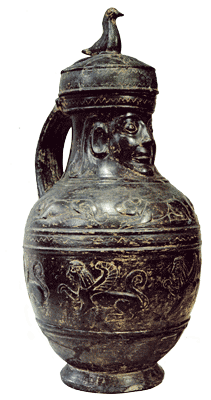
Etruscan cinerary Urn in "Bucchero". Black, highly polished and resembling metal. ca.700-550 BC. Chiusi, Etruria.CMB.

Tutorial No.7. - Image 035
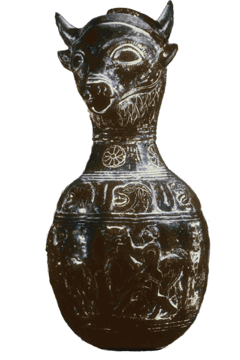
Bucchero vase with a bull's head ca.6th c. BC. From Chiusi, AMF.

Tutorial No.7. - Image 036
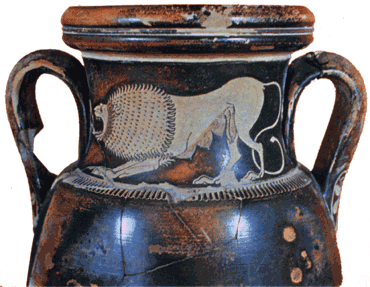
Part of a Red-figure jar from Spina ca.490 BC NMF

Tutorial No.7. - Image 037
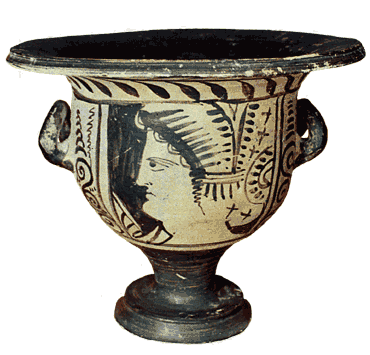
A Bell-shaped cup from Spina, fourth century BC.NMF

Tutorial No.7. - Image 038
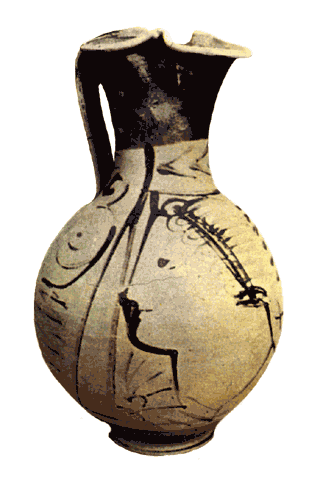
Another local Etruscan (Adriatic type) jug, fourth-third centuries BC NMF

Tutorial No.7. - Image 039
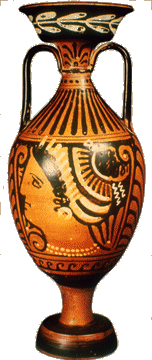
A small perfume jar 4th century BC Southern Italy. CMSOT

Tutorial No.7. - Image 040
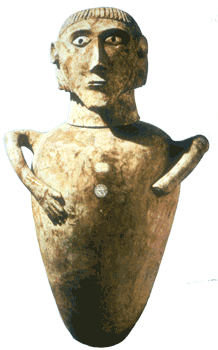
A cinerary urn with a lid in the form of the dead man's head. from Cetona 550-500 BC MAF

Tutorial No.7. - Image 041
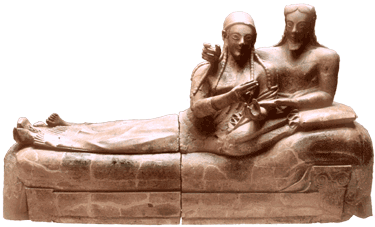
Terracotta Sarcophagus from Tomb at Cerveteri ht:100cm. ca.530 BC. Cerveteri, Etruria, Italy. VBR.

Tutorial No.7. - Image 042
Detail of the two heads: Terracotta Sarcophagus from Tomb at Cerveteri ht:100cm. ca.530 BC. Cerveteri, Etruria, Italy. VBR.

Tutorial No.7. - Image 043
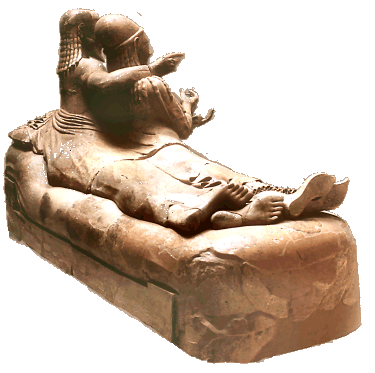
A back view of the Terracotta Sarcophagus from Tomb at Cerveteri ht:100cm. ca.530 BC. Cerveteri, Etruria, Italy. VBR.

Tutorial No.7. - Image 044
Detail of the back of the figures: Terracotta Sarcophagus from Tomb at Cerveteri ht:100cm. ca.530 BC. Cerveteri, Etruria, Italy. VBR.

Tutorial No.7. - Image 045
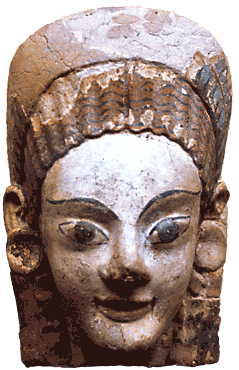
Painted ceramic head of a girl from the eaves of a temple or shrine at Caere ca.530 BC BM.

Tutorial No.7. - Image 046
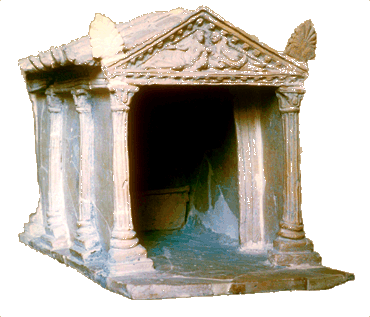
A small clay model of an Etruscan temple found in a tomb ht:20cm VGR.

Tutorial No.7. - Image 047
Reconstruction of part of the gable of an Etruscan temple VGR.

Tutorial No.7. - Image 048
Antefix from 6th-5th c. BC temple of Juno at Lanuvium. ht:38cm

Tutorial No.7. - Image 049
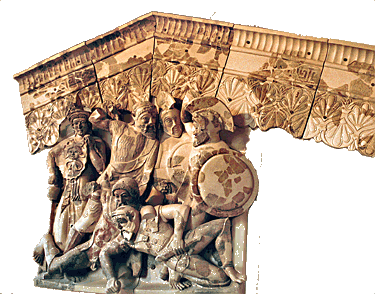
Part of a nearly lifesize figure group of terracotta figures which stood on the tympanum shelf (triangular gable roof platform) of a temple at Pyrgi. ca.460 BC VGR.

Tutorial No.7. - Image 050
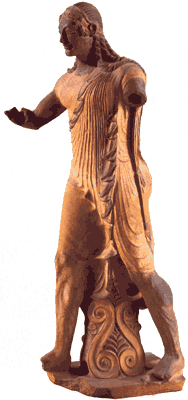
A near complete lifesize ceramic figure of Apollo made by Vulca and from Veii. ca.500 BC. VGR

Tutorial No.7. - Image 051
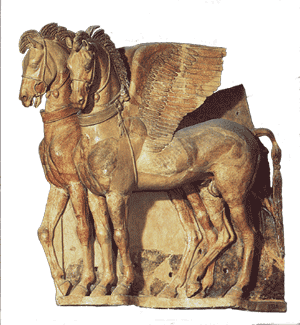
Two terracotta winged horses from a temple in Tarquinia. 4th century BC NMT.

Tutorial No.7. - Image 052
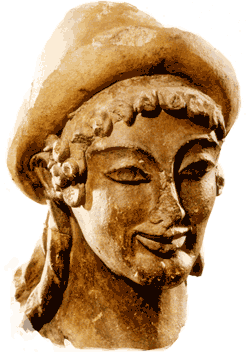
Life-size Head of the God Hermes from Veii. ca.500 BC VGR.

Tutorial No.7. - Image 053
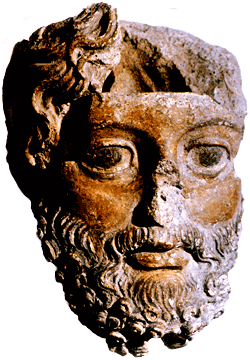
Part of a sculpted ceramic head, probably Zeus .Traces of paint showing. ca. 520-480 BC. VGR.

Tutorial No.7. - Image 054
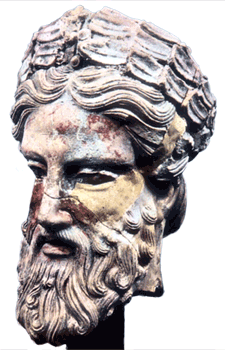
Terracotta head of a male god from the Belvedere temple in Orvieto ht:27cm ca. 450-400 BC.

Tutorial No.7. - Image 055
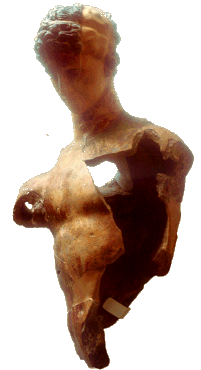
Part of the head and torso of a near lifesize ceramic figure of a young god. ca.3rd century BC. VGR.

Tutorial No.7. - Image 056
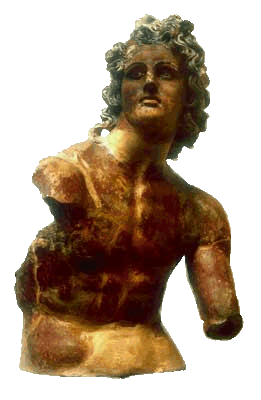
Head and torso of Apollo. Part of a sculpture showing the young god driving a chariot. From a 3rd century BC Etruscan temple at Civita Castellana. VGR.

Tutorial No.7. - Image 057
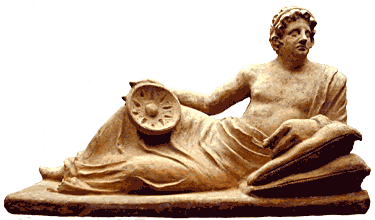
Ceramic Figure reclining on sarcophagus lid

Tutorial No.7. - Image 058
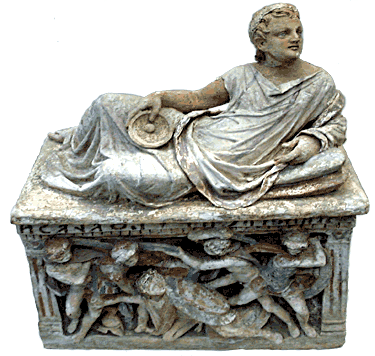
Terracotta funerary burial urn ca.150 BC

Tutorial No.7. - Image 059
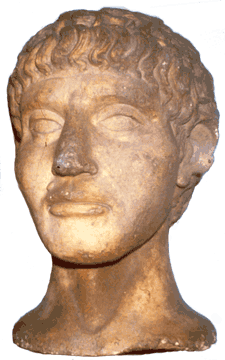
Terracotta death mask of a man ca 300-200 BC. BM.

Tutorial No.7. - Image 060
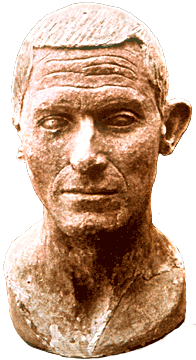
Terracotta head of old man. ca.30 BC ht:25cm VGR

 |
A Megalithic Culture
Massive Stone Structures
 061 Stonehenge, the megalithic monument of standing stones on Salisbury Plain, England. Built ca.3000-1000 BC.
061 Stonehenge, the megalithic monument of standing stones on Salisbury Plain, England. Built ca.3000-1000 BC.
Priests, priestesses and local chieftains were probably the leading figures in most of the small communities of temperate Europe until the middle of the second millenium. From then on until the Romans crossed the Alps, it seems that conflict between various tribes for territory and metal ores became widespread.
With no recorded evidence of their culture, nor any discoveries, lists of events or leaders written down for future generations, it is not too surprising that the conquering Romans regarded them almost as savages. So from Roman times down to the early 20th century the prehistoric Europeans featured little in history. Only in recent decades have researchers shown how false these assumptions were. The people of prehistoric Europe were highly skilled stone engineers. Many of their Megaliths still survive today.
The sheer size of the carved stone blocks involved shows that these neolithic and bronze age Europeans were masters in the skills needed to quarry, transport and erect such enormous standing stones: mehirs, megalithic tombs and sanctuaries such as that on Salisbury Plain in England. Stonehenge was begun around 3000 BC and later rebuilt and expanded by later cultures down to 1000 BC. Today, archaeologist still speculate about how and why such structures came about. Although they would have served some ritual purpose, it is doubtful if popular beliefs linking them with (later)druidical rites have any foundation.
|
 |
End of Background Information
- A Megalithic Culture


Tutorial No.7. - Image 061
Stonehenge


End of Background Information
- Age of Metals


Tutorial No.7. - Image 062
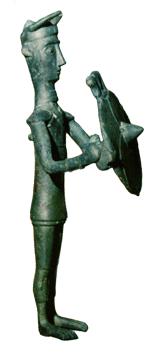
Tiny bronze statuette of a warrior ht:10cm found in Sardinia.

Tutorial No.7. - Image 063
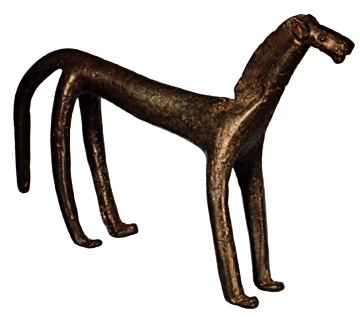
Tiny bronze horse ht:9cm ca.1500 BC. from Moravia, Czechoslovakia MMB.

Tutorial No.7. - Image 064
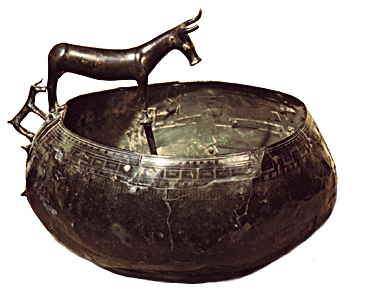
A Bronze caldron with handle in the form of a cow and calf. Diam.24cm. From Hallstatt grave, Austria NMV

Tutorial No.7. - Image 065
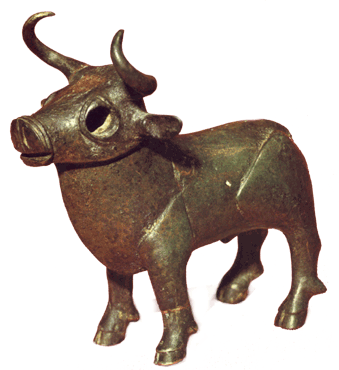
A small cast bronze bull ht:7.5cm From a sanctuary cave in Moravia, Czechoslovakia. NMV.

Tutorial No.7. - Image 066

A small dagger Mycenaean.

Tutorial No.7. - Image 067
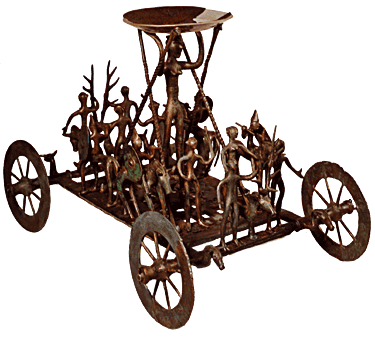
A Bronze Wagon with a female figure holding up a bowl and stags being led to sacrifice. l:35cm ht:27cm. From an urnfield grave site, Strettweg Austria. SLJG



 |
La Tène or Celtic Decoration
on the edge of the Roman World
 068 Ornamental Disk ca.300 BC. Repoussé sheet gold on bronze with filigree decoration and coral inlays. From Auvers-sur-Oise(Seine-et-Oise France BNP. 068 Ornamental Disk ca.300 BC. Repoussé sheet gold on bronze with filigree decoration and coral inlays. From Auvers-sur-Oise(Seine-et-Oise France BNP.
Swirling rhythms and a balanced arrangement of the bladder-like patterns raise the surface into dynamic curves. The outlines of filigree decoration break up the light and emphasise the intricate decoration.
The curvilinear style of the Northern Celts was crystallizing into a recognisable style before the Roman Conquest of northern mainland Europe. But quite often classical Greek ornament and patterns were copied then very creatively altered to blend into this native celtic
style.
 069 Decorated copper sheaths l:15cm. ca.300 BC. From Tal-y-Llyn,Merionethshire, Wales. MOWC. 069 Decorated copper sheaths l:15cm. ca.300 BC. From Tal-y-Llyn,Merionethshire, Wales. MOWC.
Figures and faces are integrated into a simplified Greek palmette ornament. Facial details are emphasised in a characteristic La Tène manner.
 070 A long spouted bronze pitcher ht:37cm. ca.500 BC. Kleinaspergle, Baden-Württemberg, Germany. WLS. 070 A long spouted bronze pitcher ht:37cm. ca.500 BC. Kleinaspergle, Baden-Württemberg, Germany. WLS.
This appears at first to be a Greek or Italian( Etruscan) wine pitcher. But the masks on the handle show it to have been manufactured north of the Alps.
 071 The long spouted bronze pitcher above: Detail of the face mask at the base of the handle. ca 500 BC. 071 The long spouted bronze pitcher above: Detail of the face mask at the base of the handle. ca 500 BC.
A stylised head with horns and beard - an odd hybrid, a kind of Celtic Silenus. It well illustrates a characteristic Celtic (Early La Tène) technique of incorporating foreign motifs into their Style.
 072 Large bronze boar with stylized bristles.ca.50 BC-50AD. ht:76cm.Neuvy-en-Sullias,Loiret, France. MHOO. 072 Large bronze boar with stylized bristles.ca.50 BC-50AD. ht:76cm.Neuvy-en-Sullias,Loiret, France. MHOO.
A fine example of Celtic animal art, stylised head, mouth, tusks and body, but full of nervous tension.
 073 A Stone head of a chieftain or hero wearing a neck ring. Stone ca.300 BC. ht:23.5cm. Found at Mseke-Zehrovice, Czechoslovakia. NMP. 073 A Stone head of a chieftain or hero wearing a neck ring. Stone ca.300 BC. ht:23.5cm. Found at Mseke-Zehrovice, Czechoslovakia. NMP.
The head is egg-shaped, Moustache and eyebrows have become spiral ornaments. The protruding eyes are strongly outlined, the mouth a tightly closed upward curve. Only the bronze or gold neck ring is rendered more naturalistically. Its purpose is unknown but it was found with bones of sacrificed animals in a sacred site.
 074 Ceremonial shield ca.50 BC. Repoussé bronze with red glass inlays, ht:80cm. From the River Thames at Battersea, London England. BML. 074 Ceremonial shield ca.50 BC. Repoussé bronze with red glass inlays, ht:80cm. From the River Thames at Battersea, London England. BML.
Discoveries of many bronze objects like this shield in France, Spain, north Italy and Britain are evidence of a Celtic migration from the Upper Danube into western Europe between the 7th and the 3rd centuries BC. The Celts had become proficient in bronze casting and goldsmith's work early in their history, having learned these skills from Mediterranean and Asia Minor trading contacts. This beautiful shield, found in the Thames, displays the Celtic genius for decoration. The geometric, curvilinear motifs, swirling spirals and circles enclosing coral and enamel inlay are enclosed in their turn by three circles. These patterns are used again and again in Celtic artifacts in different combinations without ever becoming monotonous. The style is of a pronounced Late British type: the continent was too strongly influenced by Roman patterns ever to develop anything like this.
 075 Back of a hand mirror engraved with tendril ornament. Bronze. length with handle:35cm. From Desborough, Nottinghamshire, England BML. 075 Back of a hand mirror engraved with tendril ornament. Bronze. length with handle:35cm. From Desborough, Nottinghamshire, England BML.
In the first century BC., the island Celts attained undisputed mastery in the decoration of flat surfaces. What might appear sheer fantasy is actually the result of deliberate composition, though the traditional motifs are transformed in a characteristic way. The decorated side of the mirror takes the swelling volutes and bladder patterns of La Tène art and refines them to the point of geometric stylisation.
 076 Part of what is thought to be a crown, known as "Petrie Horns" Bronze. From an unknown site in Ireland. NMD. 076 Part of what is thought to be a crown, known as "Petrie Horns" Bronze. From an unknown site in Ireland. NMD.
The pattern on this fragment of an object, thought to be a bronze crown, is more austere than the previous example but is most effective in bringing out the shape of the bowl structures by an off-centre design of swirling spirals. In the centuries of Roman occupation which followed, only in the British Isles (Ireland and Britain) did the Celtic style survive and for a while flourish. The influence of Rome almost extinguished this native style, but five centuries later in 5th century AD Christian monks in Ireland returned to the Celtic style combining more of the figurative style of the Germanic tribes now migrating across the North Sea to the British Isles.
|
 |
End of Background Information
- Celtic Decoration


Tutorial No.7. - Image 068
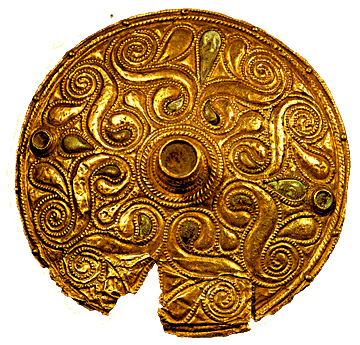
Ornamental Disk. ca.300 BC. Repoussé sheet gold on bronze with filigree decoration and coral inlays. From Auvers-sur-Oise(Seine-et-Oise France BNP.

Tutorial No.7. - Image 069
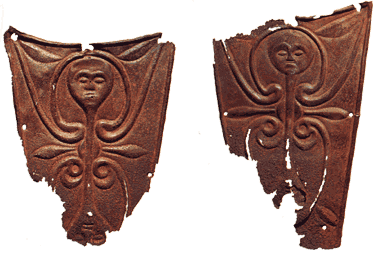
Decorated copper sheaths l:15cm. ca.300 BC. From Tal-y-Llyn,Merionethshire, Wales. MOWC.

Tutorial No.7. - Image 070
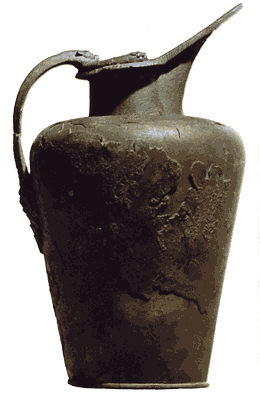
A long spouted bronze pitcher ht:37cm. ca.500 BC.Kleinaspergle, Baden-Württemberg, Germany. WLS.

Tutorial No.7. - Image 071
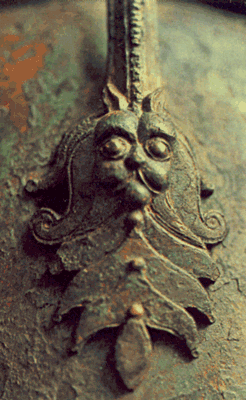
The long spouted bronze pitcher above: Detail of the face mask at the base of the handle. ca.500 BC.

Tutorial No.7. - Image 072
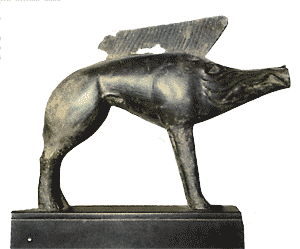
Large bronze boar with stylized bristles. ca.50 BC-50AD. ht:76cm.Neuvy-en-Sullias,Loiret, France. MHOO.

Tutorial No.7. - Image 073
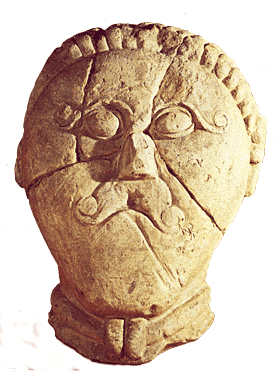
A Stone head of a chieftain or hero wearing a neck ring. Stone ca.300 BC. ht:23.5cm.Found at Mseke-Zehrovice, Czechoslovakia. NMP.

Tutorial No.7. - Image 074
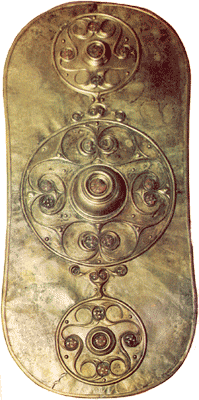
Ceremonial shield ca.50 BC. Repoussée bronze with red glass inlays, ht311/2". From the Thames at Battersea, London England. BML

Tutorial No.7. - Image 075
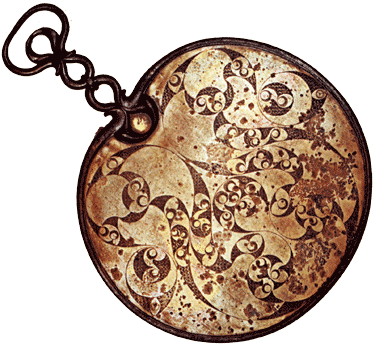
Back of a hand mirror engraved with tendril ornament. Bronze. length with handle:35cm. From Desborough, Nottinghamshire, England BML.

Tutorial No.7. - Image 076
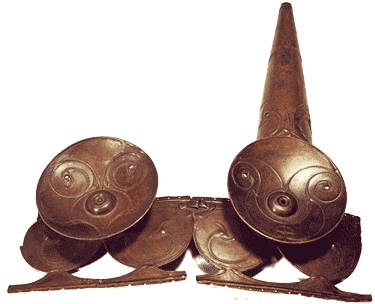
Part of what is thought to be a crown, known as "Petrie Horns" Bronze. From an unknown site in Ireland. NMD.

 |
Italy Before The Romans
Carthaginians, Greeks, Villanovans
and the Etruscans
 077 Map of Italy ca. 5th century BC Showing the important tribes and spheres of influence Although part of Europe, Italy has been influenced and part colonised from earliest times. Before 1000 BC there were already many related Italic tribes throughout Italy. By the early part of the first millennium BC. Phoenicians traders from Palestine and North Africa(Carthaginians) and Greeks from the Aegean had begun to colonise as much as they could of Italy's coastline, from the Tiber down to Sicily. Eventually they came into conflict. Celts and German tribes from across the Alps influenced development of the tribes in Northern Italy during this time. 077 Map of Italy ca. 5th century BC Showing the important tribes and spheres of influence Although part of Europe, Italy has been influenced and part colonised from earliest times. Before 1000 BC there were already many related Italic tribes throughout Italy. By the early part of the first millennium BC. Phoenicians traders from Palestine and North Africa(Carthaginians) and Greeks from the Aegean had begun to colonise as much as they could of Italy's coastline, from the Tiber down to Sicily. Eventually they came into conflict. Celts and German tribes from across the Alps influenced development of the tribes in Northern Italy during this time.
The Villanovan Culture
In northern Italy the greatest influence and migrants at the beginning of the first millennium BC., came from the Germanic and Celtic tribes from beyond the Alps. North of the Apennines in Tuscany, Emilia and in the Po valley flourished the most original and developed culture in Italy between 1000 and 800 BC. Called the Villanovan culture (after a excavated settlement near Bologna). They cremated their dead in double-cone shaped urns covered by cups or bowls turned upside down, sometimes these lids were like a warriors helmet. The Villanovans controlled the rich copper and iron mines of Tuscany and were accomplished metalworkers. In the second half of the 8th century the Villanovans of Tuscany began to be influenced artistically by Greece.
 078 A bronze girdle from the Benacci cemetery near Bologna. ca 800 BC. CMB 078 A bronze girdle from the Benacci cemetery near Bologna. ca 800 BC. CMB
This beautiful girdle is a masterpiece of Villanovan metalwork. Here the geometric decoration has formalised a common Bronze Age theme: The journey of the sun drawn by swans. The sun, its chariot and the swans are shown as a series of elegant spirals and arabesques, engraved with meticulous care. The spiral was a favourite motif in Bronze and Iron Age art.
Who Were The Etruscans
Colonists from the East, A Native Italic Tribe, Northern Invaders?
 079 Detail of Map of Italy 5th century BC: Etruscan territory and sphere of influence. 079 Detail of Map of Italy 5th century BC: Etruscan territory and sphere of influence.
How the people called Etruscans came into being is still far from settled. Today it seems most likely that this vibrant society evolved from the ninth century BC onwards out of a mix of different cultures: principally the Villanovan culture but these developments may have included Phoenician colonists and other Italic tribes in Tuscany and Umbria.
Few certain facts are known but it is now thought this was probably the beginning of the Etruscan Culture. Then during the middle of the 8th century BC. two events of great significance for the future, took place. One was the arrival of the first Greek colonists on the southern coasts of Italy and Sicily,about 750 BC. The other, a little later towards 700 BC, was the seemingly sudden emergence of
a distinct Etruscan style of art in Tuscany. By then, this culture had evolved its own language, religion, and urban way of life. It soon became powerful and militant.
The 7th century BC. Phoenician traders and Greek colonist establishing bases around the Italian coastline soon recognised, respected and at times fought against this new Italian nation - the Etruscans. But trade and exchange of metals and other needed raw materials for finished products such as pottery and jewellery for a time allowed these three civilisations to exist in relative harmony in and around Italy.
The Etruscan heartland was Etruria, between the Tiber and Arno rivers west and south of the Apennines. In any event, by the middle of the 7th century BC the chief Etruscan towns had been founded. Before reaching the Arno River in the north and incorporating all Tuscany in their dominion, the Etruscans embarked upon a series of conquests initially probably not coordinated but undertaken by individual cities. The pressing motive for expansion was that by the middle of this century the Greeks not only had obtained a grip on Corsica and expanded their hold on Sicily and southern Italy but also had settled on the Ligurian coast (northwestern Italy) and in southern France.
From the Po valley, the Etruscans made contact with the central European La Tène cultures. Etruscan conquests in the northeast extended to include what are now the modern cities of Piacenza, Modena, Parma, and Mantua. To the south they were drawn into Latium and Campania from the end of the 7th century.
This civilization reached its height in the 6th century BC. but by the end of that century its cities were under attack from many quarters. The Celts in the north, the Greeks around the coasts and their expulsion from the city of Rome in 509 BC. During the next centuries Etruscan power gradually ebbed away to be swallowed up by the growing power of Rome. However, many features of Etruscan culture were adopted by the Romans, their successors to power in the peninsula.
Etruscan Art and Architecture
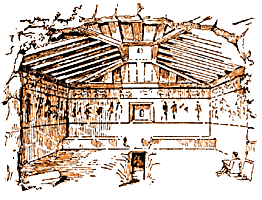 080 Old Drawing: Etruscan Tomb. Click for photo. Drawing 080 Old Drawing: Etruscan Tomb. Click for photo. Drawing
To the Etruscans the tomb was the dwelling-place of the dead in their after-life. Such tombs are still being excavated in northern Italy.
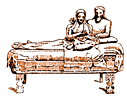 041 Drawing of a terracotta sarcophagus ca.530 BC: click for photo 041 Drawing of a terracotta sarcophagus ca.530 BC: click for photo
 082 Inside the Tomb of the Shields at Cerveteri 7th century BC 082 Inside the Tomb of the Shields at Cerveteri 7th century BC
From the 7th century BC onwards tombs were made to look like rooms, with couches around the walls for the dead to rest on.

 083 and 084 Details of Frescos from the Tomb of the Leopards, Tarquinia ca. 470 BC
083 and 084 Details of Frescos from the Tomb of the Leopards, Tarquinia ca. 470 BC
The most impressive part is the rich colourful decoration. Unique in the ancient European world were the bright naturalistic wall paintings portraying scenes of dancing drinking and celebration. Some of the walls have lost their paintings, but fortunately many tomb paintings have survived, which help us to understand their beliefs and life-styles.
 085 Detail of a dancer at the funeral games. From the Tomb of the Augers at Tarquinia ca. 530 BC 085 Detail of a dancer at the funeral games. From the Tomb of the Augers at Tarquinia ca. 530 BC
The naturalistic emphasises the Greek influence but this style of painting is less polishes and perhaps is more colourful, lively and vivacious. Richly painted walls in a style of naturalism quite different from the ancient Egyptian tomb paintings.
Etruscan Bronzes
  081 081
 086 Tiny bronze figure of an Etruscan warrior with plumed helmet ca. 5th century BC. VGR 086 Tiny bronze figure of an Etruscan warrior with plumed helmet ca. 5th century BC. VGR
An example of the vast number of tiny bronze figurines of fighting men found at various Etruscan burial sites. The Etruscans shared with the earlier Villanovans and their cousins north of the Alps, the expertise of Mining and Metalworking. The Phoenicians and the Greeks were familiar with Etruscan bronzework as early as the 7th century BC.
 087 Bronze Statue of a Chimera ca.380 BC. ht:79cm. From Arezzo FAM 087 Bronze Statue of a Chimera ca.380 BC. ht:79cm. From Arezzo FAM
A superb bronze sculpture of the Chimera, the fabulous beast with a lion's head a goat's body and a serpent tail from a Greek Myth. The Romans inherited much from Etruscan metalworking skills.
The Etruscan Temple
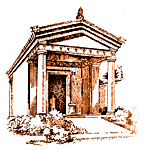
088
By the 7th century BC the Etruscan building had become strongly influenced by Greek styles. Wood, fired brick and terracotta remained the dominant building materials. Only fragments of any structures remain.
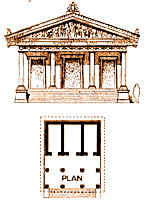 089 089
At first sight the structures appear to be Greek, but closer examination shows important differences of detail. The columns, made of wood, are smooth not fluted. The capitals are often simple saucer-shaped rings. The sides of the temple are solid walls built between and against the wooden columns. Much of the "Etruscan Classical" style was adopted by the Romans.
A small clay model of an Etruscan temple found in a tomb. It shows clearly the characteristic single front entrance(usually with front steps); closed-in side and back walls with engaged columns. Notice the terracotta decorations around the roof and filling the gable ledge(tympanum)

046 A small clay model of an Etruscan temple found in a tomb ht:20cm VGR
.
The Etruscan Arch
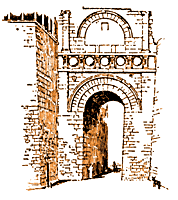 090 090
The structural Arch in brick devised by the Etruscans can still be seen in many ancient buildings of Northern Italy. Many have been repaired or virtually re-built by the Romans or later people down to the present time.
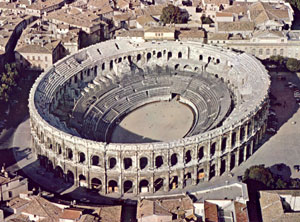 091 091
The simple brick arch of the Etruscans was adopted by the Romans, later copied in stone and from this simple form developed the many great buildings, bridges and aqueducts of the Roman Empire.
|
 |
End of Background Information
- Italy Before The Romans


Tutorial No.7. - Image 077
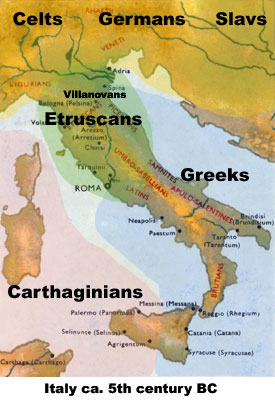
Map of Italy ca. 5th century BC Showing the important tribes and spheres of influence

Tutorial No.7. - Image 078
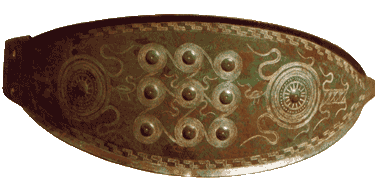
A bronze girdle from the Benacci cemetery near Bologna. ca 800 BC. CMB

Tutorial No.7. - Image 079
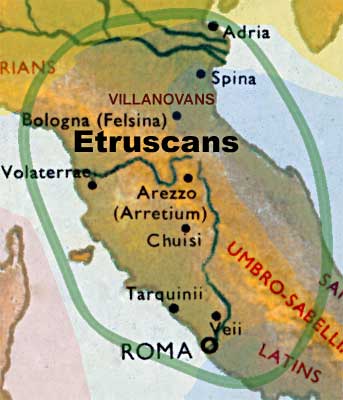
Detail of Map of Italy 5th century BC: Etruscan territory and sphere of influence.

Tutorial No.7. - Image 080
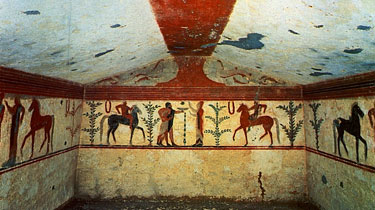
Etruscan Tomb of the Baron Tarquinia, ca.510 BC Part of a painted frieze of a procession and a libation offering. The style here is restrained, archaic and formal.

Tutorial No.7. - Image 082
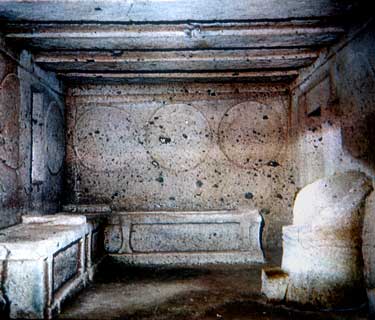
Inside the Tomb of the Shields at Cerveteri 7th century BC

Tutorial No.7. - Image 083
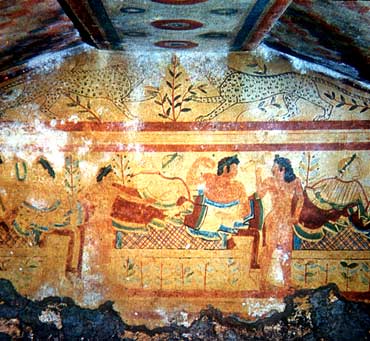
Detail of Fresco from the Tomb of the Leopards, Tarquinia ca. 470 BC

Tutorial No.7. - Image 084
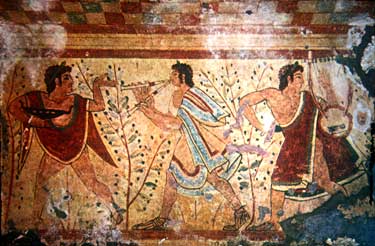
Detail of Fresco from the Tomb of the Leopards, Tarquinia ca. 470 BC

Tutorial No.7. - Image 085
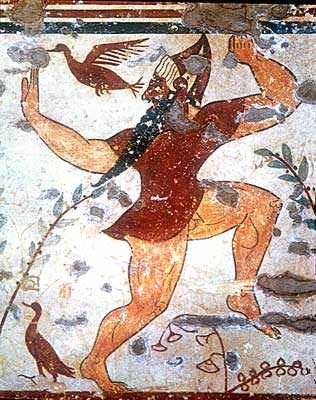
Detail of a dancer in the countryside at the funeral games. From the Tomb of the Augers at Tarquinia ca. 530 BC

Tutorial No.7. - Image 086
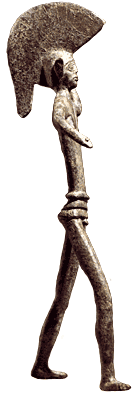
Tiny bronze figure of an Etruscan warrior with plumed helmet ca. 5th century BC. VGR

Tutorial No.7. - Image 087
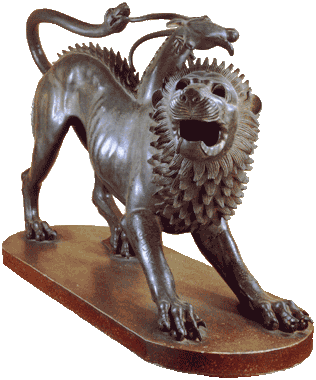
A superb bronze sculpture of the Chimera, the fabulous beast with a lion's head a goat's body and a serpent tail from a Greek Myth ca.380 BC. ht:79cm. Arezzo FAM

That was the last illustration.
I hope you have found tutorial No.7 interesting and perhaps useful.
Tutorial No.8 is a survey of ceramics in the Roman World.

That was the last illustration in this tutorial

©2002 Victor Bryant

To Index Home Page
|
 |
































































































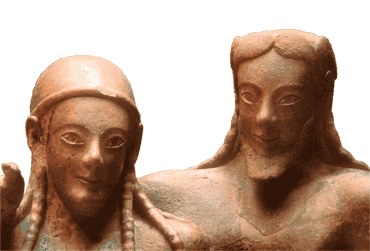



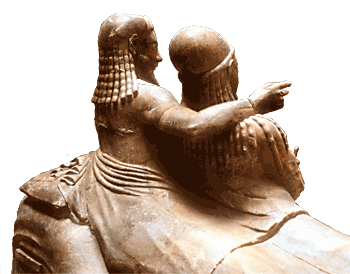





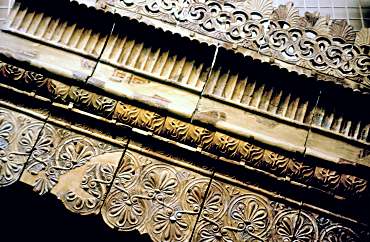

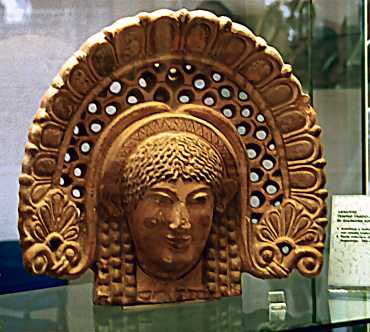



























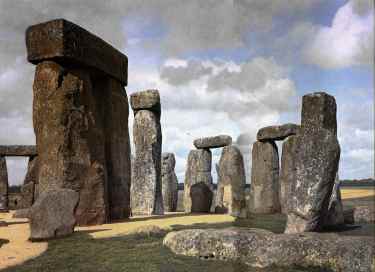













































































 081
081

 089
089 090
090 091
091